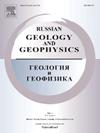Periglacial-Aeolian Polygonal Surface Structures in the Tibetan Plateau
IF 1
4区 地球科学
Q3 GEOSCIENCES, MULTIDISCIPLINARY
引用次数: 0
Abstract
—The surface pattern of permafrost area in the Tibetan Plateau, with 15–20 m polygons, resembles the patterned ground of the Arctic periglacial loess plains in northeastern Eurasia and North America. However, unlike the Arctic plains, it consists of semi-stabilized modern sand dunes, up to 2.5–3.0 m high, and U-shaped epigenetic ice wedge casts inherited from an ancient polygonal network on the surface of a 10–12-m terrace of the Yangtze River. The polygonal dunes and the U-shaped sand wedges were studied in the Yangtze head-waters in the vicinity of the high-altitude research station Bei-Lu-Xe. The polygons have desert pavement floors with ventifacts, composed of Late Pleistocene alluvial gravel and debris. The dunes and wedges consist of well sorted quartz-carbonate sand with an average grains size of 2.0–2.2 mm. Ground Penetrating Radar surveys in the area revealed the permafrost table at depths varying from 2 to 4 m below the dunes. The polygonal dunes may have formed by biogenic-aeolian deposition over an ancient system of ice wedges.青藏高原冰缘风的多边形表面结构
--青藏高原永久冻土区的表面图案为15-20米的多边形,类似于欧亚大陆东北部和北美北极冰缘黄土平原的图案地面。然而,与北极平原不同的是,它由高达2.5–3.0米的半稳定现代沙丘和U形后生冰楔铸件组成,这些铸件继承自长江10–12米阶地表面的古代多边形网络。研究了长江上游贝鲁色高海拔研究站附近的多边形沙丘和U形沙楔。多边形具有沙漠路面地面,并由晚更新世冲积砾石和碎屑组成。沙丘和楔形物由分选良好的石英-碳酸盐砂组成,平均粒径为2.0–2.2 mm。该地区的地面穿透雷达调查显示,沙丘下方2至4 m深处的永久冻土表各不相同。多边形沙丘可能是由古代冰楔系统上的生物风沉积形成的。
本文章由计算机程序翻译,如有差异,请以英文原文为准。
求助全文
约1分钟内获得全文
求助全文
来源期刊

Russian Geology and Geophysics
地学-地球科学综合
CiteScore
2.00
自引率
18.20%
发文量
95
审稿时长
4-8 weeks
期刊介绍:
The journal publishes original reports of theoretical and methodological nature in the fields of geology, geophysics, and geochemistry, which contain data on composition and structure of the Earth''s crust and mantle, describes processes of formation and general regularities of commercial mineral occurrences, investigations on development and application of geological-geophysical methods for their revealing. As to works of regional nature, accelerated publication are available for original papers on a variety of problems of comparative geology taking into account specific character of Siberia, adjacent Asian countries and water areas. The journal will also publish reviews, critical articles, chronicle of the most important scientific events, and advertisements.
 求助内容:
求助内容: 应助结果提醒方式:
应助结果提醒方式:


